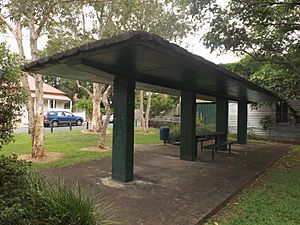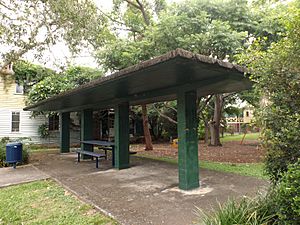Woolloongabba Air Raid Shelter facts for kids
Quick facts for kids Woolloongabba Air Raid Shelter |
|
|---|---|

Structure in 2015
|
|
| Location | 34 Sword Street, Woolloongabba, City of Brisbane, Queensland, Australia |
| Design period | 1939 - 1945 (World War II) |
| Built | c. 1942 |
| Architect | Frank Gibson Costello |
| Official name: Woolloongabba Air Raid Shelter | |
| Type | state heritage (built) |
| Designated | 6 April 2005 |
| Reference no. | 602477 |
| Significant period | 1942 (fabric) 1940s (historical) |
| Builders | Brisbane City Council |
| Lua error in Module:Location_map at line 420: attempt to index field 'wikibase' (a nil value). | |
The Woolloongabba Air Raid Shelter is a special building in Woolloongabba, Brisbane, Australia. It was built during World War II around 1942 to protect people from air attacks. This shelter was designed by Frank Gibson Costello and built by the Brisbane City Council. Today, it is recognized as a heritage site, meaning it's an important part of history that needs to be protected.
Contents
Why Were Air Raid Shelters Needed?
World War II and Australia
World War II was a huge global conflict that lasted from 1939 to 1945. At first, Australia was fighting alongside England against Germany. But on December 7, 1941, the war changed for America and Australia. Japan attacked the American fleet at Pearl Harbor in Hawaii. This brought the United States into the war, making it a truly worldwide conflict.
Soon after, Japan bombed Darwin, Australia, in February 1942. Many Australian soldiers were also captured when Singapore fell. These events made Australians worried about a possible invasion. Plans were quickly made to defend Australia and use Queensland as a major base for the war in the Pacific.
Brisbane's Role in the War
Brisbane became a very important city during World War II. It was the largest city in Queensland and the most northern big city in Australia. Because of this, many military leaders and important facilities were set up there.
For example, General Douglas MacArthur, who led the Allied Forces in the Southwest Pacific, had his headquarters in Brisbane. General Sir Thomas Blamey, who led the Australian Forces, also used buildings at the University of Queensland. With so many important military operations, Brisbane was a likely target for enemy bombing. This meant quick action was needed to protect the people living there.
Protecting People from Air Raids
To keep people safe, the Brisbane City Council was put in charge of "Air Raid Precautions" (ARP). This included setting up a system of Air Raid Wardens, improving firefighting, and building shelters. On Christmas Eve, 1941, everyone in Australia was told to start building shelters. Simple trenches were dug in parks and schoolyards. Windows were taped to prevent shattering, and "brownouts" (reducing lights) were used at night.
The Brisbane City Council was ordered to build 200 public shelters in the city. They started building quickly, and by June 1942, most of the shelters were finished. They also built long covered trenches in public parks, like the Botanic Gardens. These shelters were designed to hold many people and keep them safe during an attack.
What Was Special About These Shelters?
Frank Gibson Costello's Smart Design
Many buildings were needed quickly during the war, but materials and skilled workers were hard to find. Frank Gibson Costello, who was the City Architect for Brisbane from 1941 to 1952, came up with a clever idea for the air raid shelters. He designed them so they could be used for something else after the war.
Costello wanted to avoid having many unused concrete structures just sitting around. He said that if the shelters weren't needed for air raids, they could be changed into useful public buildings. His designs were inspired by modern architecture, focusing on simple shapes and practical uses.
Shelters with a Second Life
Costello's reusable shelters were often placed under large fig trees, which helped hide them from above. These shelters were built with strong concrete roofs and pillars. The outer walls, called "blast walls," could be removed after the war. This would turn the shelter into something like a bus stop or a shaded picnic area in a park.
Many of these shelters were designed to hold about 70 people. After World War II ended, most of the temporary war structures in Brisbane were taken down. But because of Costello's smart design, 20 of the 58 reusable public shelters survived. Their blast walls were removed, and they were given a new purpose, just as planned.
The Woolloongabba Air Raid Shelter was one of these special shelters. Its blast walls were removed after the war, and it became a useful structure in the Buranda playground.
What Does the Shelter Look Like Today?
The Woolloongabba air raid shelter is a rectangular concrete building. It has a strong flat roof supported by concrete pillars. The roof and pillars are painted green. The shelter is surrounded by trees and bushes and is right next to playground equipment. Inside, there's a wooden picnic table and seats. You can still see where the original walls used to be.
Why Is It a Heritage Site?
The Woolloongabba Air Raid Shelter was added to the Queensland Heritage Register on April 6, 2005. This means it's considered an important historical place for several reasons:
- A Glimpse into History: It shows how Brisbane prepared for war and how World War II affected everyday people.
- A Rare Survivor: Many air raid shelters were built, but only a few are still standing today. This makes the Woolloongabba shelter quite rare.
- A Great Example: Its strong build and location show what a typical public air raid shelter in Brisbane looked like during the war.
- Clever Design: It's a great example of how buildings were designed to be used for more than one purpose, showing smart engineering and concrete use during wartime.
- Connected to Important People: The shelter is also important because it's an example of the work done by the City Architect's Office, especially by Frank Gibson Costello, during the war.
Images for kids




